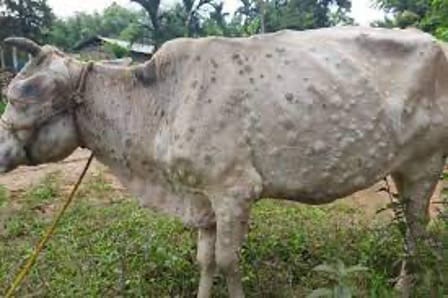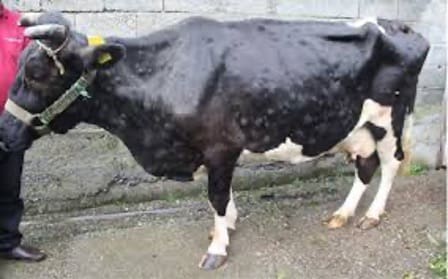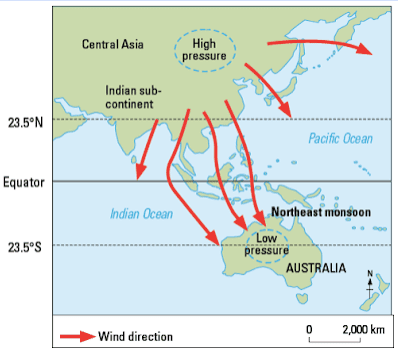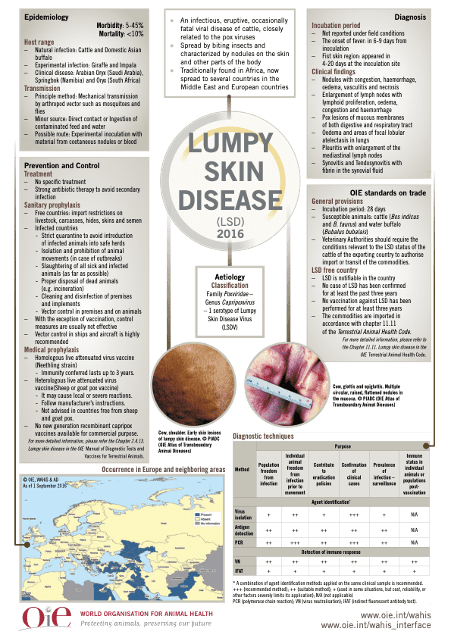The Indonesian government last night signed off on an Emergency Declaration following confirmation that Lumpy Skin Disease (LSD) has been identified in Sumatra, increasing the risk of the disease entering Australia.
The international animal health agency (OIE) is also being notified.

Photo from the internet: All types of cattle and buffalo are affected. The disease is very well named!
Lumpy skin disease is a viral disease of cattle and buffalo that can cause painful skin lesions, fever, watery eyes, loss of appetite, and a reluctance to move.
It has serious animal production implications including emaciation, decreased milk production, damaged hides and reproductive losses. While signs of disease may not be noticeable in some infected animals, in some cases it can kill the animal.
In an update issued last week, Australia’s chief veterinary officer Dr Mark Schipp warned LSD poses serious trade impacts across the live animal trade, and for exporters of dairy products, genetic materials, hides and some meat products.
It is probable that the infection was transmitted across the Malacca straights from Malaysia. The straits are only 65 km wide at their narrowest point.
It now appears likely that the virus will spread through the rest of the Indonesian archipelago to the south and east.
Once LSD reaches the eastern island of Timor, Australia will be the next country under threat.
Lumpy skin disease (LSD) is primarily transmitted by biting insects including flies and mosquitoes.
Transmission is also possible through direct contact.
LSD virus is very resistant and can survive in favourable environmental conditions for many months. It is transportable on equipment including footwear.
The disease originated in southern Africa but since the 1970’s has extended north and east through the Middle East then Turkey, Russia and China.
Since 2019 it has been spreading through Asia including India, Taiwan and Vietnam.
In 2021 it was reported in Myanmar, Thailand, Laos, Cambodia and most recently in peninsular Malaysia.
Given the history of transmission to date, there is a real possibility that Australia will become infected with this very serious bovine disease with marginal vaccines as our only protection.
Map from the OIE website in late 2021 showing ongoing LSD outbreaks in orange.
Why the disease presents a threat the Australian cattle industry
There are two main reasons why this disease presents an extremely serious threat to the Australian cattle industry:
Firstly, transmission by insects means that conventional quarantine, border controls and biosecurity are largely ineffective. With the island of Timor only 800 km from the Australian mainland, it is feasible that infected insects could travel across the ocean on the Northeast monsoon.
If the disease enters Australia, it is likely to infect the northern tropics where 100 percent cattle control is not possible so even if a vaccine is available, some animals will miss out during routine musters allowing the disease to continue to circulate in the unvaccinated stock. The large herd of wild buffalo in the Northern Territory also represents a serious potential reservoir of infection.
Secondly, the only vaccines available are far from ideal. All of the useful vaccines contain live attenuated virus. I have spoken to a dairy vet in Thailand last week who advised that while unexposed dairy cattle respond well to the vaccine with negligible side effects, dairy herds which have already been exposed to natural infection show a low level of clinical signs such as fever and skin lumps following vaccination. Despite these concerns about vaccination, Thai dairy farmers have generally decided to use the available vaccine because natural infection in unvaccinated cattle has been producing severe signs and economic loss in 30 to 40 percent of animals in the herd including fever, weight loss, reduced milk production, reduced conception rates, some abortions, secondary infections and mortalities in calves. Once the herds have been vaccinated the main focus of the disease is in calves. I have also had advice that when the vaccine was used in large dairy herds in China that there were negligible clinical signs.
Photo from the internet: The impact on the dairy industry is likely to be greatest as infection results in a significant reduction in milk production which usually lasts for the remainder of the lactation period.
The distance between Timor and Australia is about 800km. During the Northeast monsoon prevailing winds blow from the north and west across Indonesia towards the top end of Australia.
With only Java and the Eastern Islands of Indonesia standing between the Sumatran outbreak and a serious threat to Northern Australia, the Australian government will no doubt be providing every assistance possible to Indonesia to help it arrest the transmission of the virus. Indonesia has only a small but valuable cattle and buffalo herd (official statistics say 17 million head) which is likely to be devastated if the virus is not prevented from spreading throughout the archipelago.
In my opinion, this disease represents the most serious threat to the Australian cattle industry that I have seen since leaving veterinary school in 1975.
Apart from the usual biosecurity protocols, one thing that the Australian government and industry could do to protect our cattle herd from potential disaster is to harness the latest vaccine technologies that have been developed during the Covid 19 pandemic to very quickly produce a new and highly effective vaccine in time to stop LSD in its tracks.
Further information on the disease can be found in these web sites :
https://rr-asia.oie.int/en/projects/lumpy-skin-disease-lsd/
https://www.animalhealthaustralia.com.au/wp-content/uploads/dlm_uploads/Lumpy-Skin-Disease.pdf
Source: OIE





Meat and milk of effected animal from lumpy skin disease is good for human health or dangerous ?
The advice from we have recieved from the Department of Agriculture, Water and Environment is that lumpy skin disease only affects cattle and water buffalo and does not pose a risk to human health.
More information on lumpy skin disease can be found on the Department’s website here
My thinking , scientifically :
1 Sample the virus to lab
2 find what kills the virus
3 dilute/vary the antidote , & test on ‘????’ for efficacy to remediate/immunise , preferably all targets.
Step.